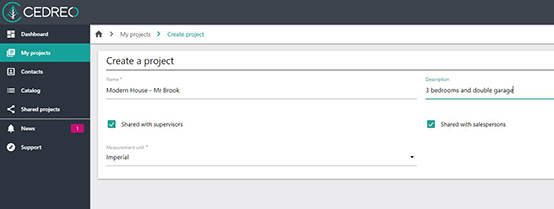The scope of work, or SOW, is arguably the most important document in any construction contract. It lays out expectations, provides everyone involved in the project with a shared vision, a common set of objectives, and a clear sense of what they need to do to bring that vision to life – at every stage in the process.
Without a clearly defined SOW, you’re vulnerable to budget overages, payment disputes, errors, and other issues that can derail a project — and by extension, your company’s reputation.
In this article, we’ll explain what exactly a scope of work is, what information belongs in an SOW, and how to write one yourself.
What Is a Scope of Work in Construction?
In construction, a scope of work (sometimes known as a statement of work), is a document that breaks down exactly what you’ve promised the client, as well as everything it takes to deliver the desired results.
The SOW clearly communicates the expectations for all involved parties. It typically includes obligations, responsibilities, and tasks for the contractor, subcontractors, vendors, and other stakeholders with a hand in the project.
It also defines project requirements, goals, and milestones, limitations and parameters, contract terms and payment schedule, and anything else that might influence a project’s outcome.
Can the Scope of Work be Changed?
The scope of work breaks down the timeline, individual responsibilities, deliverables, etc. of a given construction project. It serves as a framework that aligns the entire team and provides them with clear guidance on what they should be doing at each stage.
That said, the scope of work isn’t necessarily set in stone. It’s a well-known truth that construction projects rarely go according to plan.
Clients change their mind. You might experience delays due to supply chain issues or an unexpected storm. Contractors may be asked to perform tasks that weren’t included in the initial agreement.
The point is, there are many moving parts and external forces that must work together — and the SOW needs to be flexible enough to accommodate changing conditions.
Still any changes to the plan must be made “official.” SOWs are typically modified via change orders, which ensures that all changes are documented and approved before any further action is taken. This is critical because scope creep leads to issues like miscommunication, payment disputes, and poor alignment. You know, the issues the SOW was supposed to prevent in the first place.
Key Elements of a Construction Scope of Work
A contractor’s scope of work will vary depending on the nature of the project, who is involved, along with a number of other factors.
That said, there are a few “universal” elements that should be included in any construction scope of work template. These elements should be completed in sequential order – as you can see below, you’ll start by sketching out the big-picture and progressively add more detail.
Project overview
The project overview provides a basic summary of the project. It should include a list of deliverables and critical objectives that must be met in order to close out the project.
Project deliverables
This section should provide a detailed breakdown of all project milestones and deliverables that must be completed at each stage in the project lifecycle. You’ll need to make sure that you give contractors and subcontractors a clear picture of exactly what they need to do to ensure each deliverable meets the standards outlined in the big picture plan.
Scope details
The project scope zooms in closer, providing more details about the specific tasks and technical specifications associated with each deliverable. Here, you’ll describe the individual steps, methods, and techniques that contractors will use to complete each part of the project. Essentially, “project deliverables” tells you the “what,” while the scope details explain the “how.”
Timeline and schedule
The timeline and schedule component includes a deadline and a set of tasks and subtasks associated for each deliverable. You don’t need to provide a ton of detail here–the goal is to give contractors enough information so that they can plan around project milestones.
Project management
The last critical element you’ll want to include in your SOW is project management. This section should define the administrative processes associated with the project – things like how you’ll handle change orders, when you’ll release payment to contractors, and a record of contract terms and legal requirements.
Note that Cedreo’s built-in collaboration tools can help you make and track all project changes and quickly get stakeholder approval before moving forward.
Share projects with supervisors or salespeople from the “My Projects” tab, then capture feedback, and collect signatures to approve changes.

Image Source
Scope of Work Fundamentals
Beyond the “key elements” we outlined in the last section, there are a few scope of work “fundamentals” that will help you put together an effective document. Here’s a quick overview:
Use a construction scope of work template
A statement of work template defines what to include in an SOW – or not. While requirements will likely vary by client and project, a template ensures that every statement of work includes all essential information. What’s more, because you won’t be starting from scratch with every new project, you’ll save hours of unnecessary work.
Include all details
Make sure you have a detailed breakdown of each service you provide and everything that service entails, including:
- Materials
- Costs
- Contractors
- Subcontractors
- Required skills
- Tasks
- Projected timeframe
- Etc.
Get clear on client requirements
Before any part of the project can get underway, you’ll need to meet with the client to discuss project requirements.
Once you’ve gathered the initial requirements, you might mock up a few designs to ensure you understand their vision. Then from there, you can work together to refine project details and start developing a plan.
Communicate with your team
Transparency is everything. Be sure to schedule regular meetings to discuss project progress and inform the team of any changes they should know about.
Additionally, it’s a good idea to look at your “collaboration stack” to ensure that everyone on the team has the tools they need to access key information and communicate directly with each other – whether they’re on the job site or in the office.
Clarify maintenance agreements
Finally, you’ll need to clarify maintenance agreements with both the client and your team.
On the client side, you’ll need to get real clear on how changes are handled.
For example:
- What do they need to do in order to submit a change request?
- Will certain changes be performed free of charge?
- If so, what are the terms and conditions for those changes?
- How much will you charge for last minute requests – i.e. changing materials or adding a deliverable?
- Etc.
Additionally, the details of your maintenance agreement need to be communicated with your team. How will changes/requests be handled internally? Make sure you put it in writing so everyone is on the same page.
How to Write a Scope of Work for a Construction Project
Writing a scope of work comes with a different set of best practices than, say, a blog post or a project proposal.
Your best bet is to stay focused on the primary objective: providing a clear, detailed breakdown of the entire project. But – it’s easier said than done.
Here are a few tips to help you get it right – at least after a couple rounds of edits:
Use plain language
Your SOW should be easy for everyone to understand – immediately.
You’ll want to avoid ambiguous or vague language, as well as jargon or unnecessarily complex words.
If you absolutely must use jargon/construction terminology, you’ll need to create a glossary. See, while your contractors and their teams might be well-versed in the lingo, other stakeholders – like clients, sales and customer service reps, and certain suppliers might not be.
Establish objectives and deliverables
The next thing you’ll want to think about is project objectives – both at the project-level and for individual deliverables.
Goals must be both specific and measurable – with a clear description of performance standards, materials, time, and what criteria contractors and subcontractors will be evaluated against.
Keep in mind that you’re also setting expectations with the client. That means, you’ll need to make sure that you’re being realistic about costs, time, materials, etc.
Break down the SOW
A construction project typically is long, complex, and composed of many different people, parts, and deliverables. It’s a lot to take in all at once.
As such, you’ll want to break up the work into smaller parts. Start by making a list of your milestones and objectives. Then, one by one, describe the work that needs to be completed. What steps are involved? What tasks need to be completed?
Ultimately, the goal is to ensure that everyone involved can follow the flow of work and track the project’s progress. Contractors should be able to immediately understand where things stand – what work has already been completed and what needs to happen next.
Assign responsibilities
Once you’ve broken the SOW into individual milestones, steps, and tasks, you’ll want to assign that work to the right people.
Ideally, you have a list of trusted contractors you already work with. In which case, you’ll want to ask for their input before making any staffing decisions. Ask them what subcontractors to hire for specific tasks. Find out if they have any recommendations for who else you might hire based on the skills you need for this job. If they’re not available, see if you can get a referral for someone who is.
Use visuals and be transparent
Beyond speaking in clear, simple language, it’s a smart idea to reinforce key concepts with photos, floor plans, and renderings. This will eliminate any ambiguity that might still be present, ensuring that everyone is working with a shared understanding of what the final product will look like.
You might use Cedreo tools to help with this step. For example, 3D renderings can be used to finalize designs with the client in real-time during client meetings.
They can also help stakeholders understand how individual milestones fit in with the bigger picture – that way, each task is performed in context.

Image Source
Retrieve signatures
Finally, you’ll need to collect signatures from all contractors and subcontractors. This is a simple, yet important step, as it helps you avoid potential disputes or scope creep that could undermine the project.
Everyone involved must sign a copy of the SOW to confirm they have read the document and understand their responsibilities. You might also require contractors to sign any time a milestone is completed.
Implementing a Scope of Work
We’ve covered the scope of work fundamentals, best practices, and key elements. But– before we wrap things up, here are a few tips for successfully putting your SOW into action.
Monitor your project
Throughout the entire project lifecycle, you’ll want to measure your performance against the timeline and performance metrics outlined in the scope of work. This allows you to identify any areas where you may need to step in with a course correction to get things back on track.
Manage adjustments
You also want to make sure you have a plan for handling changes to the project once it’s underway. How will you handle requests for new deliverables or materials that weren’t documented in the original scope of work? You’ll need to establish a workflow for managing change orders, communicating new requirements to the team, and ensuring that the client signs off on additional costs and updated timelines.
Check your work against your SOW
Before you present the final product to the client, you’ll want to check your work against the SOW to ensure that all deliverables and requirements have been met – and that they match up with the specifications outlined in the official doc.
Essentially, you’re doing another once over to make sure nothing slips through the cracks – that way, you’ll avoid running into rework, delays, or anything else that might cause a client to choose a different construction company for their next project.
Final thoughts
Bottom line: putting together a detailed scope of work is a crucial step toward making sure your construction project is a success.
Cedreo’s home building and design software can help you create effective SOWs that get the desired results. Together, the platform’s collaboration tools, 2D and 3D floor plan generator, and photorealistic renderings clarify needs, communicate ideas, and manage project changes with ease.
Sign up for a free account to get started.



